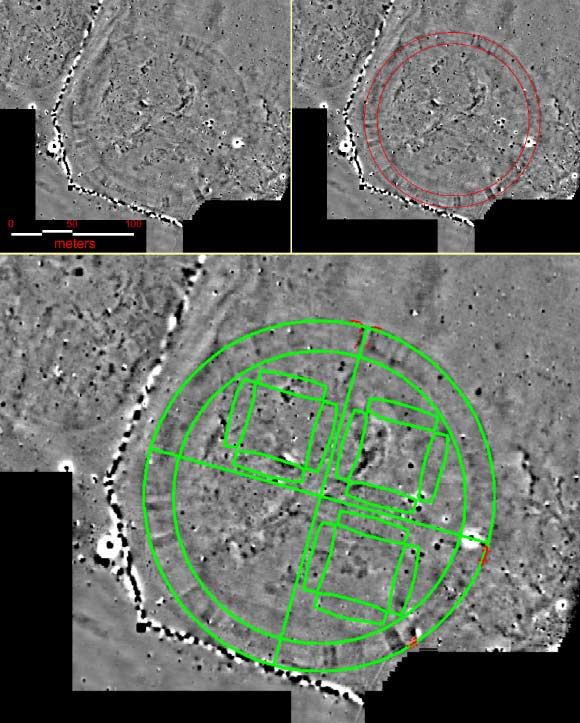Archaeologists led by Dr Nanna Holm of the Danish Castle Center have discovered a massive Viking ring fortress near Køge, a seaport about 39 km southwest of Copenhagen.

This image shows the Trelleborg-type Viking fortress of Fyrkat. Image credit: Heritage Agency of Denmark.
The Viking Age appears to be an epoch-making watershed era, characterized by wide-reaching upheavals – not only in what is now Denmark, but also throughout the entire Nordic region.
The most amazing archaeological testimony from this period is the seven so-called Trelleborg fortresses, including Nonnebakken, Aggersborg, Fyrkat and the famous Trelleborg. Six of them have been dated to around 980 CE – the reign of King Gorm the Old’s son, King Harald I Bluetooth of Denmark.
The fortresses are characterized by a ring rampart with an appurtenant moat and four covering gate openings. They had a rigorous geometric street system, a division of the internal surface area into four square-shaped blocks. Within each of these blocks, there were four longhouses positioned in the form of farmhouses constructed around a quadrangle. All of the four facilities have a uniform and rigorous geometric architecture and a stringent symmetry, which clearly manifests itself in the fortifications’ circular forms and the gate openings’ placement with respect to the four corners of the world.
The newly-discovered Trelleborg-type fortress – the eighth of its kind – is a huge monument.
“The fortress measures 145 meters from side to side,” Dr Holm said. “We recognize the Trelleborg fortresses by the precise circular shape of the ramparts and by the four massive gates that are oriented at the four corners of the compass.”
“Our investigations show that the new fortress was perfectly circular and had sturdy timber along the front,” she said.
“We have so far examined two gates, and they agree exactly with the Trelleborg plan. It is a marvelous find.”

Geophysical survey of the Viking ring fortress near Køge, Denmark. Image credit: Helen Goodchild / Danish Castle Center.
The team carried out a detailed, non-invasive, survey of the site, prior to excavation.
“By measuring small variation in the earth’s magnetism we can identify certain archaeological features without destroying anything,” explained team member Prof Søren Sindbæk of Aarhus University.
“In this way we achieved an amazingly detailed ‘ghost image’ of the fortress in a few days. From this survey we knew exactly where we had to put in excavation trenches to get as much information as possible about the mysterious fortress. “
The archaeologists said the fortress was a real military installation, and probably also the scene of fighting.
“We can see that the gates were burned-down; in the north gate we found massive, charred oak posts,” Dr Holm said.
“The burned wood in the gates will make it possible to determine the age by means of radiocarbon dating and dendrochronology. The samples have been sent, and we will be eager to hear the results.”
“The site may prove to be an important discovery in the Viking history of Denmark. We are eager to establish if the castle will turn out to be from the time of King Harald I Bluetooth, like the previously known fortresses, or perhaps a former king’s work.”
Prof Sindbæk added: “so far, only a small part of the fortress has been excavated. The list of unresolved issues is long.”







